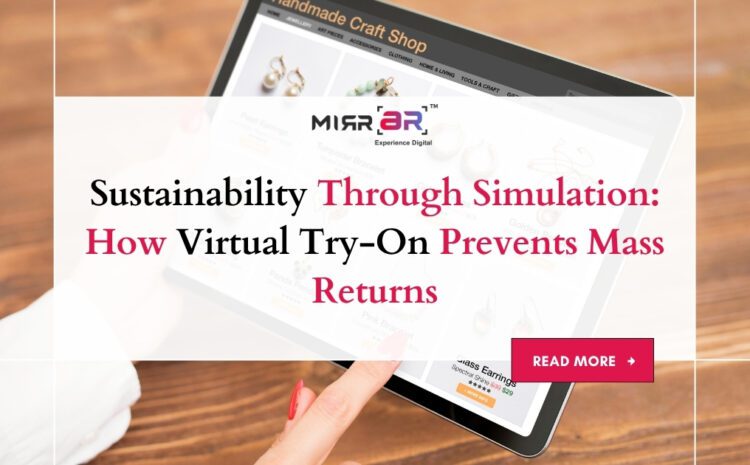In the fast-paced world of e-commerce, one often-overlooked challenge contributes heavily to environmental waste: product returns. From misfitting clothes to wrongly perceived colors and styles, millions of online orders are sent back every year. This cycle not only erodes profit margins but also creates a massive carbon footprint through shipping, repackaging, and waste disposal.
Enter Virtual Try-On (VTO) — a technology-driven solution that not only boosts customer experience but also plays a significant role in promoting sustainable fashion and retail practices. Brands like MirrAR are leading the shift, using AI and AR to transform how customers shop while reducing environmental impact through simulation-based shopping.
The Problem: E-Commerce Returns Are Unsustainable
According to global retail studies, up to 30% of all online purchases are returned, compared to just 8-10% in physical retail. In fashion and accessories, this number soars even higher due to incorrect sizing, visual mismatches, or simply impulse buying.
Every return means:
- Additional transportation emissions
- Wasted packaging materials
- Resold, landfilled, or incinerated products
- Increased logistical and handling costs for brands
For many companies, returned products cannot be resold as new due to wear and tear or cost inefficiencies. This unsustainable loop has far-reaching consequences for both the environment and the economy.
Virtual Try-On: A Simulated Solution to a Real Problem
Virtual Try-On (VTO) technology allows customers to digitally try products — from apparel and accessories to eyewear and jewelry — using augmented reality or 3D models before making a purchase. Rather than guessing sizes or imagining how something might look, VTO lets consumers make confident, informed decisions.
Platforms like MirrAR take this a step further by offering:
- Real-time 3D visualization
- Facial and body mapping
- Customizable sizing and fit features
- Try-before-you-buy tools in web and in-store formats
By reducing guesswork, VTO minimizes dissatisfaction, which in turn dramatically reduces return rates.
Reducing Returns, One Try-On at a Time
Here’s how VTO reduces returns:
1. Accurate Product Visualization
VTO offers high-fidelity, true-to-life simulations. Customers can see how a ring sits on their finger, how sunglasses frame their face, or how a dress falls on their body type — all before purchasing. This increases confidence in product choice.
2. Improved Sizing and Fit Confidence
Through AR overlays and AI-driven analytics, virtual try-ons can suggest best-fit sizes or highlight how a garment will behave in real life. When customers get the right size the first time, they’re far less likely to return the item.
3. Personalization That Matters
By using user data (with privacy in mind), brands can tailor the virtual experience to each individual. MirrAR’s no-code configurator allows even boutique brands to launch personalized try-on experiences that guide purchasing decisions intelligently.
Sustainability: The Ripple Effect
Reducing returns is not just about saving money — it’s about making retail greener.
1. Lower Carbon Emissions
Fewer returns mean fewer shipments. This translates directly into less fuel consumption, fewer delivery miles, and lower CO₂ emissions.
2. Less Waste
Returned items often end up in clearance or landfill. With VTO improving first-time purchase accuracy, more products stay with their buyers, decreasing the waste burden on brands and municipalities.
3. Reduced Resource Use
Each return means more packaging, repackaging, warehouse labor, and back-end processing. Eliminating unnecessary returns helps brands optimize operations and conserve resources.
A Business Case for Sustainability
While VTO aligns with environmental goals, it also makes financial sense:
- Higher conversion rates due to increased buyer confidence
- Fewer reverse logistics costs
- Stronger brand loyalty from eco-conscious consumers
- Better customer experience with engaging, immersive journeys
According to case studies, brands implementing VTO see up to 40% reduction in return rates and up to 60% increase in engagement time on product pages. This isn’t just a sustainable decision — it’s a strategic one.
MirrAR’s Mission: Driving Sustainable Commerce with Innovation
As a leader in the VTO space, MirrAR offers end-to-end digital try-on solutions that empower fashion, beauty, and jewelry brands to become both tech-savvy and environmentally responsible.
With features like:
- MirrAR LIVE for real-time virtual shopping assistance
- WebAR integration for seamless e-commerce adoption
- 3D configurators for immersive product exploration
…MirrAR helps brands transform how customers shop and how the planet breathes.
The Future: Simulation as Sustainability Standard
As regulations tighten around climate impact and consumers demand more sustainable solutions, simulation-based shopping will become the norm. VTO is no longer a “nice-to-have” — it’s an essential layer in the retail tech stack.
Soon, the question won’t be “Should we invest in Virtual Try-On?” but rather, “How can we use simulation to further our sustainability goals?”
Conclusion
The retail industry is at a crossroads. The choice is between continuing the cycle of wasteful returns or embracing intelligent simulation tools like Virtual Try-On to build a cleaner, smarter future.
By preventing mass returns, VTO isn’t just making shopping more convenient — it’s leading the charge for a more ethical, efficient, and sustainable retail world.
And in this movement, MirrAR is not just a tool. It’s a partner in progress.
